Dogs
A Guide to Poisonous Daffodils for Dogs

In our guide on poisonous daffodils for dogs, we reveal the dangers these flowers pose. Daffodils contain lycorine, causing vomiting. All parts are toxic, with bulbs being most harmful. Ingestion leads to vomiting, diarrhea, and pain. Severe cases can cause convulsions. Signs include vomiting, diarrhea, and salivation. Dangers are higher in bulbs, requiring prompt vet care. Clear the mouth, contact a vet, and don't induce vomiting alone. Prevent exposure by training dogs to avoid daffodils and seek vet treatment for poisoning. Act fast for a better outcome; more insights await ahead.
Key Takeaways
- Daffodils are toxic to dogs, causing vomiting and abdominal pain.
- All parts of the daffodil plant pose a danger.
- Bulbs contain higher concentrations of harmful substances.
- Immediate veterinary care is crucial for suspected ingestion.
- Prevention includes keeping daffodils out of reach and training dogs to avoid them.
Daffodils Toxicity in Dogs
Daffodils can be harmful to dogs due to the presence of lycorine, an alkaloid that induces vomiting. It's vital to recognize that all parts of the daffodil plant are toxic to dogs, but the bulbs contain the highest concentration of this harmful substance.
If consumed, daffodils can lead to various symptoms such as vomiting, diarrhea, and abdominal pain in our furry friends. In severe cases, large ingestions can result in convulsions and low blood pressure, posing a significant threat to their health.
To safeguard the well-being of our canine companions, it's important to be watchful and prevent them from accessing daffodils. If you suspect that your dog has ingested any part of a daffodil plant, immediate veterinary consultation is necessary.
Signs of Daffodil Poisoning
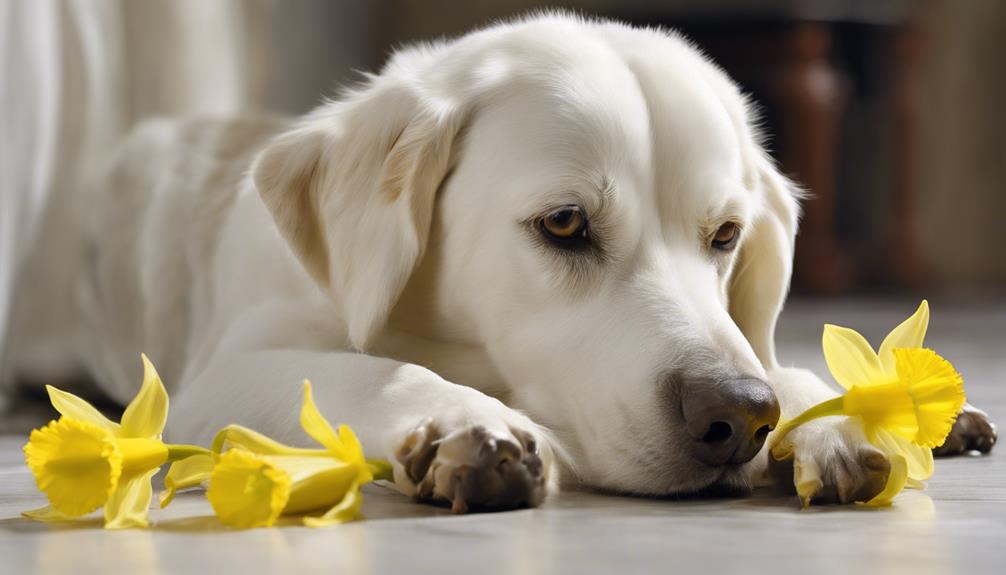
Upon ingestion, dogs may exhibit symptoms such as vomiting, diarrhea, abdominal pain, and excessive salivation as signs of daffodil poisoning. When dealing with daffodil poisoning in dogs, it's important to be aware of the following symptoms:
- Vomiting: Dogs may vomit repeatedly after consuming daffodils, which can be a clear indication of poisoning.
- Diarrhea: Look out for changes in your dog's stool consistency or frequency, as diarrhea is a common symptom of daffodil toxicity.
- Abdominal Pain: Dogs experiencing daffodil poisoning may show signs of discomfort in their abdominal area, such as whining or restlessness.
- Excessive Salivation: If you notice your dog drooling more than usual, it could be a sign of poisoning from daffodils.
- Weakness: Daffodil poisoning can cause dogs to become weak or lethargic, showing a lack of energy and enthusiasm for activities.
If your dog displays any of these symptoms after ingesting daffodils, seek immediate veterinary attention to guarantee proper care and treatment. Remember, daffodils are toxic to dogs, and prompt action is essential for their well-being.
Daffodil Bulb Dangers for Dogs

When dogs ingest daffodil bulbs, they're at risk of severe health problems due to the higher toxicity levels compared to the flowers. Daffodil bulbs contain a substance called lycorine, which is more concentrated in the bulbs than in the flowers, making them more toxic.
If a dog chews or digs up daffodil bulbs and ingests them, it can lead to various symptoms of toxicity. These symptoms may include vomiting, diarrhea, and abdominal pain. It's essential to recognize the signs of bulb ingestion in dogs promptly to seek appropriate veterinary care.
Dogs that are known to explore and chew on plants in the garden are at a higher risk of bulb toxicity. Keeping daffodil bulbs out of reach and ensuring that your furry friend doesn't have access to them can help prevent accidental ingestion and potential health issues.
If you suspect your dog has consumed daffodil bulbs or is showing symptoms of bulb ingestion, seek immediate veterinary attention for proper evaluation and treatment.
Immediate Actions for Daffodil Ingestion
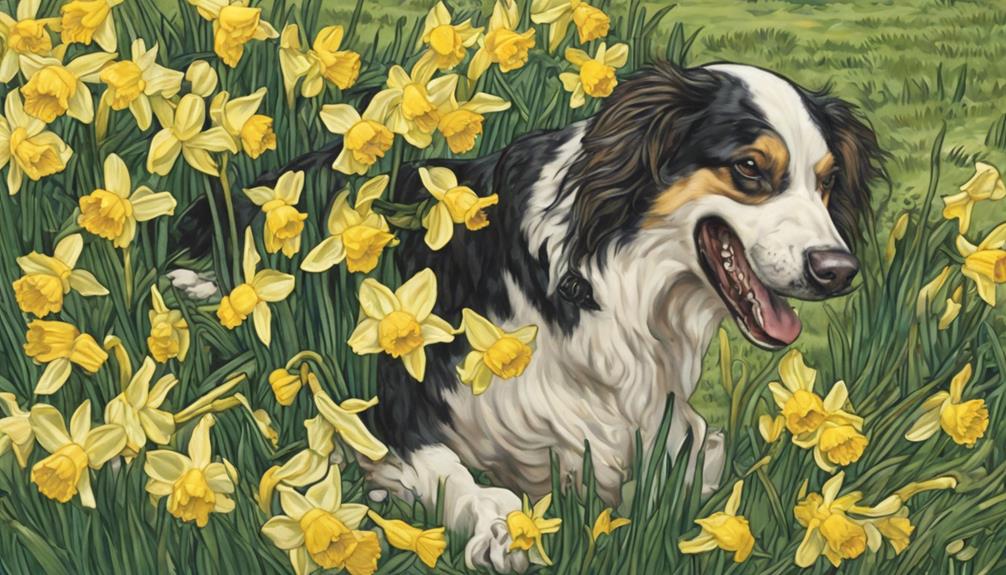
After discovering daffodil ingestion in a dog, the immediate actions to take include removing any remaining plant matter from the dog's mouth and contacting a veterinarian promptly, especially for significant ingestions.
Here are some vital steps to follow:
- Clear the Mouth: Guarantee there are no more daffodil pieces in the dog's mouth.
- Call the Vet: Get in touch with a veterinarian immediately, especially if the ingestion was significant.
- Consider Costs: Be prepared for potential consultation fees when seeking professional help.
- Avoid DIY Vomiting: Refrain from inducing vomiting at home without proper guidance from a vet.
- Act Quickly: Time is of the essence; swift action can lead to a better outcome for your furry friend.
Preventing Daffodil Exposure to Dogs
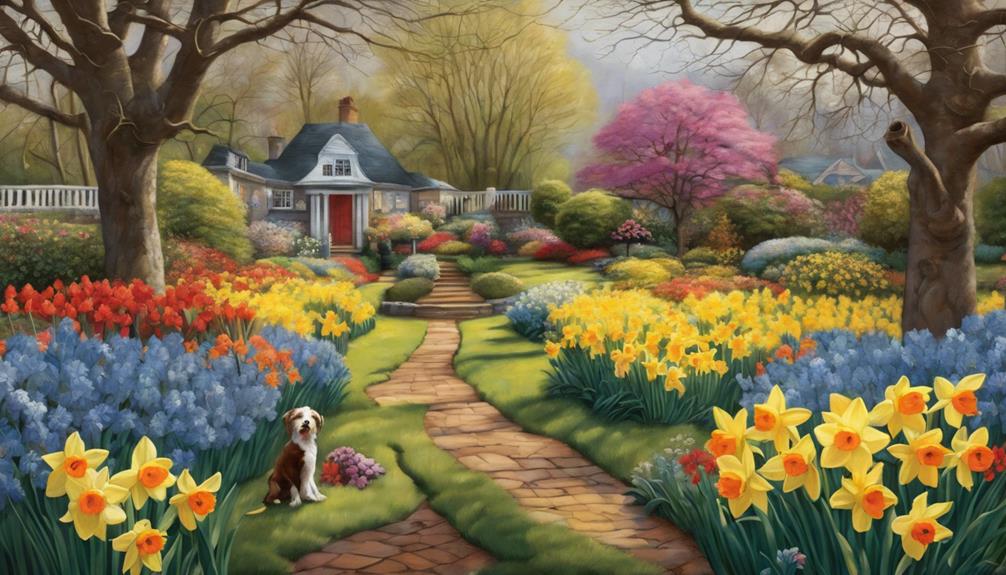
To safeguard our canine companions from potential harm, it is important to implement measures that prevent daffodil exposure. Here are some practical ways to keep your dogs safe from toxic plants like daffodils:
| Preventive Measure | Description |
|---|---|
| Keep daffodils out of reach | Place daffodils in areas inaccessible to dogs, like high shelves or closed rooms. |
| Train dogs to 'leave it' | Teach dogs to avoid daffodils by using the command 'leave it' when near them. |
| Replace with dog-friendly plants | Consider replacing daffodils with safe plants to create a pet-friendly environment. |
Additionally, using fencing or netting can help restrict access to daffodils in outdoor areas, preventing accidental ingestion. If you suspect your dog has ingested daffodils, contact the Pet Poison Helpline immediately for guidance. By being proactive in preventing exposure to toxic plants, we can create a safer environment for our beloved pets.
Recognizing Daffodil Poisoning Symptoms

To ensure the well-being of our dogs, it's essential to be able to identify the symptoms of daffodil poisoning swiftly. Here are some key signs to look out for if you suspect your dog has ingested daffodils, which are toxic to dogs:
- Vomiting: Dogs may exhibit frequent and persistent vomiting if they've consumed daffodils.
- Diarrhea: Look for diarrhea that's unusual in frequency or consistency compared to your dog's regular bowel movements.
- Abdominal Pain: Dogs suffering from daffodil poisoning may display signs of discomfort in the abdominal area.
- Convulsions: In severe cases, daffodil ingestion can lead to convulsions or seizures in dogs.
- Low Blood Pressure: Keep an eye out for symptoms such as weakness, lethargy, or fainting, which could indicate low blood pressure due to daffodil toxicity.
If you observe any of these severe symptoms or suspect your dog has ingested daffodils, seek immediate veterinary assistance for proper diagnosis and treatment.
Veterinary Treatment for Daffodil Toxicity
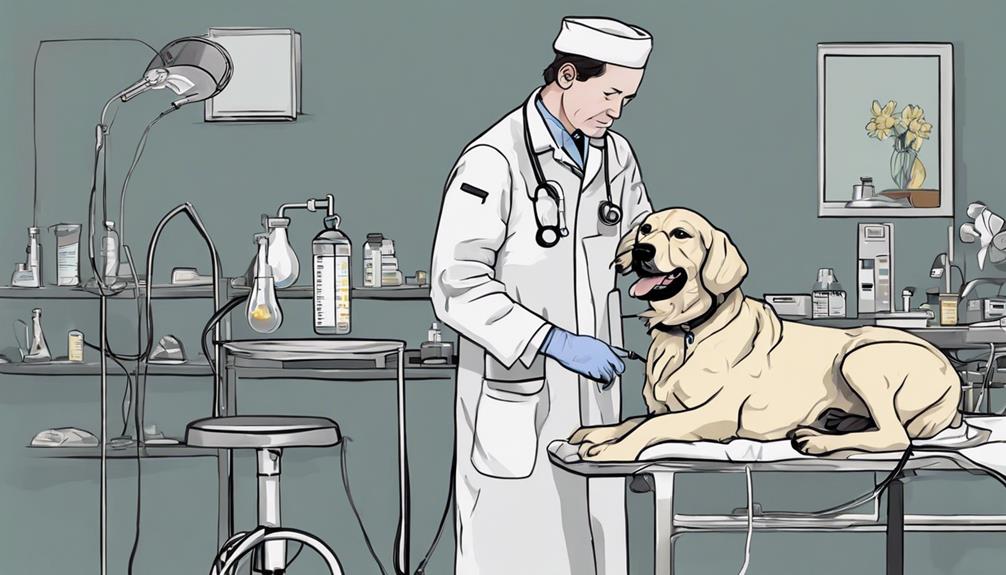
Veterinary professionals typically employ various treatment methods to address daffodil toxicity in dogs, focusing on removing toxins, supporting organ function, and managing symptoms. When a dog ingests daffodils, inducing vomiting may be necessary to expel the plant material from the system. Additionally, administering activated charcoal can help absorb toxins and prevent further absorption. Essential fluids play a vital role in daffodil poisoning treatment by maintaining hydration levels and supporting organ function during the recovery process. Medications are often used to control symptoms like vomiting, diarrhea, and abdominal pain.
It is important to seek veterinary treatment promptly if you suspect your dog has ingested daffodils. The veterinarian will assess the situation and determine the appropriate course of action, which may include the administration of activated charcoal and intravenous fluids. By following the guidance of veterinary professionals and providing necessary care, you can help your furry friend recover from daffodil toxicity effectively.
Recovery Process After Daffodil Ingestion

Effective monitoring during the recovery process after daffodil ingestion is crucial to safeguard the well-being of affected dogs. To guarantee a smooth recovery journey for your furry friend, consider the following key points:
- Close Observation: Keep a vigilant eye on your dog for any signs of lingering symptoms or new complications.
- Hydration: Make sure your dog has access to fresh water at all times to prevent dehydration, a common issue post-ingestion.
- Follow-Up Vet Visits: Schedule follow-up appointments with your veterinarian to monitor progress and address any concerns promptly.
- Gentle Exercise: Encourage light physical activity to promote circulation and aid in the elimination of toxins from the body.
- Nutritious Diet: Provide a balanced and healthy diet to support your dog's recovery and overall well-being.
Management of Daffodil Poisoning in Dogs

When managing daffodil poisoning in dogs, it's important to watch for symptoms like vomiting, drooling, and diarrhea.
Immediate veterinary care is essential to assess the severity of the poisoning and start treatment promptly.
Potential long-term effects, such as lung damage, may require ongoing monitoring and care to guarantee the best outcome for our furry friends.
Symptoms to Watch
Monitoring for symptoms such as vomiting, diarrhea, abdominal pain, and excessive salivation is crucial in managing daffodil poisoning in dogs. Keep a close eye on your furry friend for the following signs:
- Vomiting: Dogs may regurgitate frequently after ingesting daffodils.
- Diarrhea: Watch for loose or watery stools, which can indicate toxicity.
- Abdominal Pain: Dogs may show signs of discomfort by whining or avoiding being touched.
- Excessive Salivation: Increased drooling is a common symptom of daffodil poisoning.
- Weakness: Dogs may appear lethargic or have difficulty standing or walking.
If you notice any of these symptoms, contact a veterinarian immediately for guidance on the next steps to safeguard your dog's well-being.
Immediate Veterinary Care
For immediate veterinary care in cases of daffodil poisoning in dogs, our team suggests taking prompt action to minimize potential risks and guarantee the best outcome for your pet.
Daffodils are poisonous to dogs and can cause severe symptoms if ingested. If you suspect your dog has eaten any part of a daffodil, it's vital to seek veterinary help immediately.
Treatment may involve inducing vomiting to remove the toxic substances, administering activated charcoal to absorb any remaining toxins, and providing IV fluids to keep your pet hydrated. Quick action within the first 24 hours is essential and can lead to a better prognosis for your furry friend.
Continued monitoring for complications like dehydration or secondary infections is also important. Remember, daffodils can be potentially toxic to your dog, so prevention and quick intervention are key.
Potential Long-Term Effects
To manage potential long-term effects of daffodil poisoning in dogs, consistent veterinary follow-up and appropriate medication may be necessary. It's essential to monitor your dog closely for any signs of severe respiratory depression or lung damage, which can result from inhalation exposure to daffodil toxins.
Additionally, continued steroid treatment might be needed to address respiratory complications effectively. Monitoring for dehydration and secondary infections is also essential during the recovery phase.
To prevent future incidents, it's important to keep daffodils out of reach and educate pet owners on plant toxicity. Remember, the prognosis is generally good with timely treatment within the first 24 hours of ingestion.
Costs Associated With Daffodil Poisoning Treatment

Understanding the financial implications of treating daffodil poisoning in dogs can vary considerably, with costs typically ranging from $300 to $3,000. When a dog ingests daffodils, timely treatment is vital to prevent severe complications and potentially lower expenses. It's important to take into account the cost of veterinary fees, medications, and any additional treatments that may be necessary.
To prepare for unexpected veterinary expenses, pet insurance could be a valuable investment. Consulting with veterinary professionals can offer guidance on managing the costs associated with daffodil poisoning treatment. Keep in mind that consultation fees may apply when reaching out to a local veterinarian for assistance.
Frequently Asked Questions
How Much Daffodil Is Poisonous to Dogs?
Eating even small amounts of daffodil can be harmful to dogs. The toxic component lycorine in daffodils can cause vomiting, diarrhea, and abdominal pain.
The severity of the reaction depends on how much is consumed. If a dog ingests any part of a daffodil, immediate veterinary care is essential to prevent serious health issues.
To keep dogs safe, always make sure daffodils and their bulbs are out of reach.
What Should I Do if My Dog Eats a Daffodil?
If your dog consumes a daffodil, act quickly – remove any plant material from their mouth, then contact your vet immediately. Don't attempt home remedies before seeking professional advice. Inform the vet how much and which part of the daffodil your dog ingested.
Capture images or obtain samples of the daffodil for identification. Your prompt action can help guarantee your furry companion receives the care they need to remain safe.
What Part of Daffodils Are Poisonous?
The most poisonous part of daffodils to dogs is the bulb.
Daffodil bulbs contain high levels of lycorine and alkaloids, which can cause severe symptoms like vomiting, diarrhea, convulsions, and low blood pressure when ingested by dogs.
It's important to keep these bulbs out of reach to prevent accidental poisoning.
If a dog eats daffodil bulbs, immediate veterinary care is necessary to address potential toxicity and symptoms.
Which Bulbs Are Poisonous for Dogs?
Daffodil bulbs are toxic to dogs, containing lycorine and alkaloids that can cause serious reactions like vomiting, diarrhea, convulsions, and low blood pressure.
Immediate veterinary help is vital if a dog ingests daffodil bulbs. Contact the APCC at (888) 426-4435 or a local veterinarian for assistance.
Conclusion
To wrap up, remember to safeguard your furry companions from toxic daffodils by being attentive and proactive. Quickly seek veterinary care if you suspect your dog has consumed any part of a daffodil plant.
Prevention is crucial in avoiding the potential hazards of daffodil toxicity. Stay vigilant and informed to guarantee your pet's well-being and happiness.
Stay safe, stay smart, and keep those daffodils out of reach!
Dana is our Lead Content Writer, bringing a wealth of knowledge and expertise to our team. With a background deeply rooted in animal studies and a profound love for all creatures, Dana is dedicated to crafting engaging and informative content that resonates with our audience. With Dana at the helm, you can trust that our content is accurate and engaging, catering to the diverse interests of animal enthusiasts everywhere.
Dogs
Top 7 Goose Dog Names for Your Feathered Friends
Looking for the perfect name for your goose dog? From classic choices to mythical options, explore the top 7 names starting with 'C' that will leave you excited for more!

When choosing names for your goose dogs, consider classic options like Lucy and Jack for a timeless feel. Try geographic-inspired names such as Norman or Montana to add a sense of place. Opt for two-syllable names like Daisy or Charlie for easy recall during training. Pay homage to history with names of famous geese from literature, showcasing intelligence and loyalty. Explore mythological names like Freki or Lysander to add a touch of magic to your pet's identity. For more inspiration on top goose dog names, discover humorous and popular hunting dog options to fully personalize your feathered companions.
Key Takeaways
- Classic Goose Dog Names for a timeless and elegant choice.
- Geographical-Inspired Goose Dog Names for a unique sense of place.
- Two-Syllable Goose Dog Names for easy memorization and communication.
- Historical References Goose Dog Names for depth and significance.
- Mythological Goose Dog Names for a mystical and legendary persona.
Classic Goose Dog Names
What makes classic goose dog names stand out among other naming options for your feathered companion?
Classic names like Lucy, Oliver, Grace, Jack, and Daisy aren't just names; they're timeless choices that exude elegance and sophistication. When you give your goose dog a classic name, you aren't only reflecting traditional characteristics associated with geese but also adding a touch of charm to their identity.
These names have a certain grace about them that can evoke a sense of nostalgia and warmth. Imagine calling out 'Lucy' or 'Oliver' as your feathered friend waddles by—it just feels right.
Choosing a classic name for your goose dog can create a special bond between you and your pet. It sets the tone for a relationship built on tradition and everlasting love. So, when considering a name for your feathered companion, don't overlook the beauty and timelessness that a classic name can bring to your goose dog's life.
Geographical-Inspired Goose Dog Names

When exploring geographical-inspired goose dog names, one can draw inspiration from various locations or regions to add a unique sense of place to their feathered companion's identity. These names offer a special way to connect your goose dog to a specific area, culture, or landscape, making their name more than just a label but a reflection of your interests and experiences. Here are some examples of geographical-inspired goose dog names:
| Geographical-Inspired Goose Dog Names |
|---|
| Norman |
| Gulch |
| Bridger |
| Montana |
| Idaho |
Each of these names carries the essence of a place, whether it's the rugged charm of Montana or the serene beauty of Idaho. Choosing a geographical-inspired name for your goose dog not only adds a touch of personality but can also spark conversations about your favorite destinations and the stories behind the name. So, why not give your feathered friend a name that speaks volumes about your love for different places?
Two-Syllable Goose Dog Names
Two-syllable goose dog names are a popular choice for pet owners looking for names that are easy to remember and pronounce. These names, like Daisy, Charlie, and Lucy, offer a simple yet rhythmic sound that appeals to many.
They're versatile options suitable for various dog breeds, making them effective for training and communication purposes.
Popular Goose Dog Names
Discussing popular goose dog names, we find that two-syllable options are highly favored for their ease of use and engaging qualities. These names offer a perfect balance between simplicity and effectiveness in training and communication.
With a rhythmic flow, they capture the attention of both the dog and the owner, creating a harmonious sound when called out. Pet owners often choose two-syllable names for their goose dogs due to their friendliness and approachability. From Bella to Buddy, these names have a charming appeal that resonates well with our feathered friends.
When selecting a name for your goose dog, consider the two-syllable options as they aren't only practical but also convey a sense of warmth and connection.
Unique Goose Dog Names
Let's explore some unique two-syllable names for your goose dog that can add character to your furry companion.
- Choose a name that resonates with your goose dog's personality.
- Opt for a name that rolls off the tongue easily during training sessions.
- Consider a name that reflects the bond you share with your feathered friend.
Historical References Goose Dog Names

When considering historical references for goose dog names, we can draw inspiration from famous geese in literature. These names often pay homage to iconic geese characters from classic stories and fairy tales.
Incorporating such historical references can infuse depth and significance into your pet's identity.
Famous Historical Goose Dogs
Historical references reveal the significant role played by famous goose dogs in guarding property and herding geese. These hunting dogs were invaluable for protecting geese from harm and ensuring their safety on farms and estates. Goose dogs formed strong bonds with the geese they herded, showcasing their intelligence and loyalty in their work.
- Goose dogs were essential for guarding property and herding geese.
- They protected geese from predators and intruders.
- Some historical goose dogs were known for their intelligence and loyalty.
Mythical Goose Dog Names
Drawing inspiration from ancient stories and folklore, mythical goose dog names add a touch of enchantment to your pet's identity. These names often reflect tales from Greek, Norse, Roman, or Native American mythology, bringing a sense of mystery and magic to your feathered friend.
By choosing a mythical goose dog name, you not only honor historical references but also create a unique and intriguing persona for your pet. Imagine calling out names like Apollo, Odin, Jupiter, or Thunderbird during playtime or training sessions. These names not only sound majestic but also carry a sense of ancient wisdom and power.
Embrace the world of myths and legends by bestowing a mythical goose dog name upon your loyal companion.
Iconic Literary Goose Dogs
Exploring the world of classic literature uncovers a treasure trove of iconic goose dogs, each bearing a name steeped in historical significance and storytelling allure.
- Loyal Argos: Inspired by Homer's 'The Odyssey,' this faithful hound waited twenty years for his master's return, symbolizing loyalty and devotion.
- Courageous Fang: From the pages of J.K. Rowling's 'Harry Potter' series, this fierce and protective dog exemplifies bravery in the face of danger.
- Wise Huan: Derived from J.R.R. Tolkien's 'The Silmarillion,' Huan is a legendary wolfhound with unmatched wisdom and cunning.
These names not only pay homage to timeless literary works but also infuse your goose dog with the rich history and legacy associated with these iconic characters.
Mythological Goose Dog Names

Exploring ancient myths and legends inspires our quest for the perfect mythological names for our goose dog. These names hold a mystical and legendary quality that can truly elevate your pet's persona. Names like Freki, meaning 'ravenous' in Norse mythology, or Lysander, associated with Greek mythology and meaning 'liberator,' bring a depth of history and significance to your feathered friend.
Selecting a mythological name for your goose dog adds an intriguing element to their identity, setting them apart with a touch of ancient charm. Whether you choose a name like Occata, inspired by Roman mythology, or Selkie, a Celtic mythological creature, each option carries a unique story and character.
Embracing a mythological goose dog name not only adds a layer of depth but also sparks curiosity and wonder about the folklore behind the chosen name. Let your pet embody the magic and allure of these ancient tales with a perfect mythological name that resonates with their spirit.
Humorous Goose Dog Names
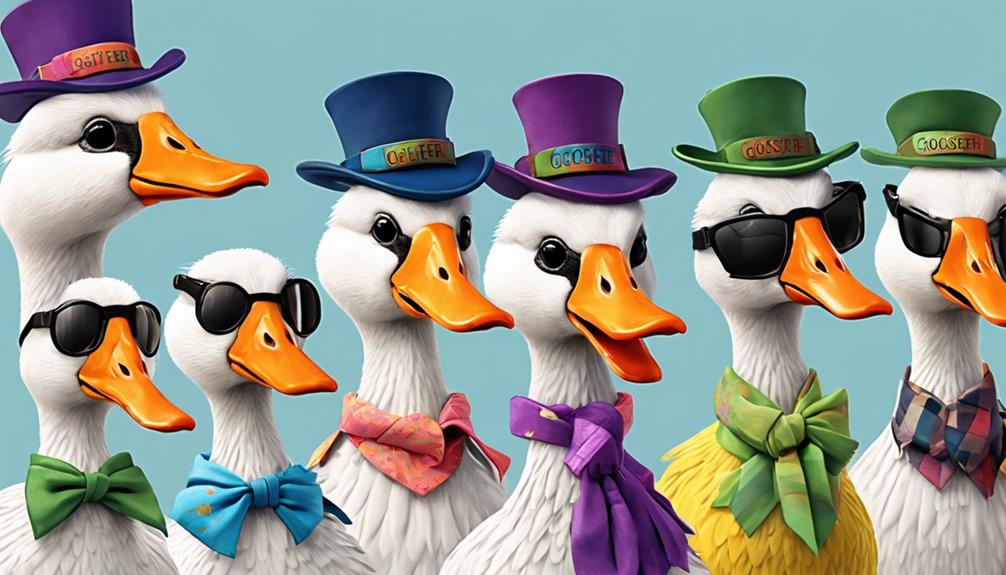
Let's dive into some chuckle-worthy options for naming your goose dog that will bring a smile to everyone's face. When it comes to choosing amusing names for your feathered friend, creativity and a touch of wit can make all the difference.
Here are three hilarious goose dog names that are sure to spark joy and laughter:
- Quack-Fu Expert: Picture your goose dog striking ninja poses while honking like a kung-fu master!
- Sir Honks-A-Lot: This name adds a touch of grandeur to your goose dog's playful antics, perfect for a majestic bird.
- Waddle Wiggle: Capture the essence of your goose dog's waddling walk and tail-wagging excitement with this endearing and amusing name.
These names not only showcase your unique sense of humor but also make your goose dog stand out in social media posts, captivating the hearts of your followers with their charm and whimsy.
Popular Hunting Dog Goose Names

We've compiled a list of popular hunting dog names inspired by the world of geese and hunting. When naming your hunting dog, consider drawing inspiration from pop culture.
Many people find influence in dogs they've seen in movies or on YouTube clips. Names like 'Max' from 'The Secret Life of Pets' or 'Marley' from 'Marley & Me' can evoke happy memories and add a touch of familiarity to your hunting companion.
Additionally, movies featuring birds or bird-like characters can also serve as inspiration for naming your hunting dog. Think of names like 'Rio' from the animated movie 'Rio' or 'Woody' inspired by the character from 'Toy Story'. These names not only reflect your love for hunting and the outdoors but also add a fun and personal touch to your dog's identity.
Frequently Asked Questions
What Is a Good Name for a Coon Dog?
A good name for a coon dog reflects its hunting prowess and heritage. Names like Ranger, Tracker, Scout, or Hunter are popular choices. They pay homage to nature and enhance the bond between owner and dog.
What's a Good Name for a Goose?
We believe naming a goose is essential; it strengthens our bond. A perfect name captures their essence. It's like a love letter in a word. Let's find a name that speaks to our hearts.
Is Goose a Popular Dog Name?
Goose is an uncommon dog name, making it stand out. While not popular, it can be a charming and distinctive choice. We find it unique and quirky, perfect for sparking conversations and showcasing creative flair.
What Is the Dog Name for Friendship?
We believe the perfect dog name for friendship is one that reflects the deep bond shared between a dog and its human. Choosing names like Buddy or Pal can emphasize the special companionship and loyalty between us.
Conclusion
To sum up, choosing a name for your goose dog is an important decision that can reflect their personality and your relationship with them.
Whether you opt for a classic, geographical-inspired, historical, mythological, humorous, or popular hunting dog name, the key is to choose one that resonates with you and your feathered friend.
Naming your goose dog is like finding the perfect pair of shoes – it should fit just right and make you both walk proudly together.
As our Editor-in-Chief, James plays a pivotal role in ensuring the quality and integrity of our content. With a keen eye for detail and a passion for storytelling, James oversees the editorial process here at A Place for Animals. With years of experience in content editing, James ensures that every piece of content meets our high standards of accuracy and clarity. Under James’ guidance, you can rest assured that the content you read is informative and impeccably crafted.
Dogs
The Meaning Behind Ozaras Name
Yearning for a name that signifies treasure and brilliance? Uncover the intriguing depths of Ozara's meaning and significance.
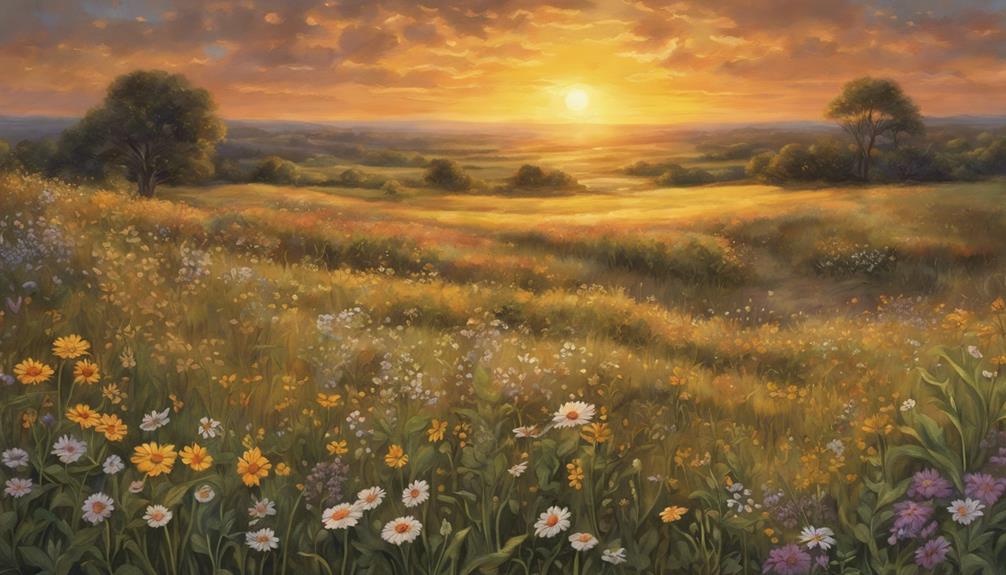
Exploring the name Ozara uncovers a rich blend of Hebrew and Serbian roots. In Hebrew, it symbolizes treasure and wealth, while in Serbian, it denotes luminosity and brilliance. This name carries both material prosperity and spiritual radiance, reflecting a depth of meaning. Ozara resonates with themes of abundance and beauty. Its historical evolution shows it was once chosen for noble boys, maintaining its distinction to modern times. As a less common name ranked #10732 for baby girls in 2022, it appeals to those seeking originality. Choosing Ozara can symbolize hope, wealth, and inner light, inviting a deeper understanding of its significance.
Key Takeaways
- Ozara signifies treasure and wealth in Hebrew, luminosity and brilliance in Serbian.
- Represents material and spiritual abundance, connecting to rich cultural traditions.
- Historically given to noble boys for its value and distinction.
- Currently a unique choice for baby girls, ranking low in popularity.
- Symbolizes wealth, inner light, and positivity, inspiring beauty in life.
Origin of the Name Ozara
The origin of the name Ozara traces back to Hebrew and Serbian roots, reflecting meanings of treasure and radiance respectively. In Hebrew, Ozara signifies treasure or wealth, carrying a sense of value and abundance. This interpretation adds a layer of richness to the name, symbolizing something precious and coveted.
On the other hand, in Serbian, Ozara is derived from words meaning to make radiant or radiant, emphasizing qualities of luminosity and brilliance. These dual linguistic origins contribute to a name that embodies both material and spiritual abundance, as well as a dazzling, radiant presence.
The blend of these Hebrew and Serbian influences gives Ozara a unique and multifaceted significance. It captures the essence of treasure and radiance, infusing the name with a sense of glamour and individuality. Understanding the etymology of Ozara provides insight into the layers of meaning and symbolism embedded within this beautiful and evocative name.
Cultural Significance of Ozara

Exploring the cultural significance of Ozara reveals a rich tapestry of meanings that resonate deeply with Hebrew and Serbian heritage. In Hebrew culture, Ozara symbolizes wealth and treasure, embodying values of abundance and prosperity.
For Serbian speakers, Ozara is associated with radiance and luminosity, reflecting concepts of brightness and beauty. Naming a child Ozara can be a profound way to honor Hebrew or Serbian heritage, connecting the individual to rich cultural traditions.
The name Ozara may hold special appeal to those who value richness and beauty in both literal and metaphorical senses. Understanding the cultural significance of Ozara can deepen one's connection to the name's origins and meanings, offering insight into the heritage it represents.
When considering baby names, Ozara stands out as a choice that carries with it a sense of cultural depth and significance, making it a meaningful option for parents seeking to honor Hebrew or Serbian roots.
Historical Evolution of Ozara
Delving into the historical evolution of Ozara reveals a fascinating journey through its Hebrew roots to its modern-day connotations. The name Ozara, originating from Hebrew, holds profound meaning and significance, especially when bestowed upon a baby boy. Let's explore the evolution of Ozara through the ages:
| Time Period | Description | Significance |
|---|---|---|
| Ancient Times | Ozara was commonly given to baby boys, symbolizing riches and blessings. | Reflects the traditional values of prosperity. |
| Medieval Era | The name Ozara gained popularity among noble families, signifying wealth and abundance. | Showcased a sense of prestige and status. |
| Modern Day | Ozara continues to be a unique choice for baby boys, embodying positivity and beauty. | Retains its distinctive charm and allure. |
Through these historical shifts, Ozara has maintained its essence as a name of value and distinction for baby boys, carrying forward its legacy of radiance and prosperity.
Popularity and Usage of Ozara

Moving from its historical evolution, let's now examine the current popularity and usage of the name Ozara. In 2022, Ozara is ranked #10732 for baby girls in the US, not making it into the top 1000 names. Its popularity peaked at 9 per million babies in the same year, showing a fluctuating trend. The name experienced a low point with only 5 entries in 2014. Data from the Social Security Administration reveals these variations regarding Ozara's ranking over the years.
Although not a top contender regarding popularity, Ozara still holds a unique charm for those seeking a less common name for their baby girl. Its rarity adds an exclusive touch, making it a distinctive choice for parents looking for something off the beaten path. While it may not be as widespread as some other names, Ozara's appeal lies in its individuality and the sense of originality it brings to the table.
Symbolism and Interpretation of Ozara
Symbolizing wealth and treasure in Hebrew culture, the name Ozara carries a profound significance that resonates with positivity and radiance. Ozara's symbolism goes beyond mere words; it encapsulates a sense of abundance and brilliance that can brighten anyone's day.
Here are some key points to help you understand the symbolism and interpretation of the name Ozara:
- Ozara embodies the concept of prosperity and richness in Hebrew tradition.
- The name Ozara reflects a sense of inner light and brightness, symbolizing hope and optimism.
- Choosing the name Ozara for your child can bring a sense of abundance and positivity into their life.
- In Hebrew, Ozara is associated with treasure and valuable possessions, signifying the preciousness of the individual bearing the name.
- Ozara's symbolism can inspire those around her to see the beauty and richness in life, spreading joy and radiance wherever she goes.
Embrace the wealth of meaning behind the name Ozara and let its positive energy shine bright in your life.
Frequently Asked Questions
What Does Sara Mean in the Bible?
We believe Sara in the Bible signifies nobility and motherhood. It reflects a woman of faith and God's promises fulfilled. Sarah, as the wife of Abraham, embodies strength and grace, showcasing the power of belief and divine blessings.
What Is the Meaning of the Name Sara in the Quran?
We explored the Quran to unravel the essence of the name Sara. Discovering its roots in the story of Ibrahim's devoted wife revealed Sara's significance in embodying patience, faith, and nobility, inspiring us deeply.
What Is the Meaning of the Name Zoya?
We adore the name Zoya! It means 'life' in Greek, exuding vitality and charm. A popular choice in Russia and Ukraine, it captures a positive and energetic essence. Zoya is perfect for parents seeking beauty and significance.
Is Zara an Arabic Name?
We're here to clarify: Zara is not an Arabic name. It originates from Hebrew and means 'princess.' Despite its popularity in various cultures, Zara's essence lies in royalty and not Arabic roots. Hope that clears things up!
Conclusion
To wrap up, the name Ozara holds a profound meaning rooted in its cultural significance and historical evolution. Its popularity and symbolism make it a unique and impactful choice for those seeking a name with depth and symbolism.
So, when considering a name for your child, remember the power and passion that comes with the name Ozara. Choose wisely, for a name can shape a destiny.
As our Editor-in-Chief, James plays a pivotal role in ensuring the quality and integrity of our content. With a keen eye for detail and a passion for storytelling, James oversees the editorial process here at A Place for Animals. With years of experience in content editing, James ensures that every piece of content meets our high standards of accuracy and clarity. Under James’ guidance, you can rest assured that the content you read is informative and impeccably crafted.
Dogs
Hyacinth Poisoning: A Comprehensive Guide for Dogs
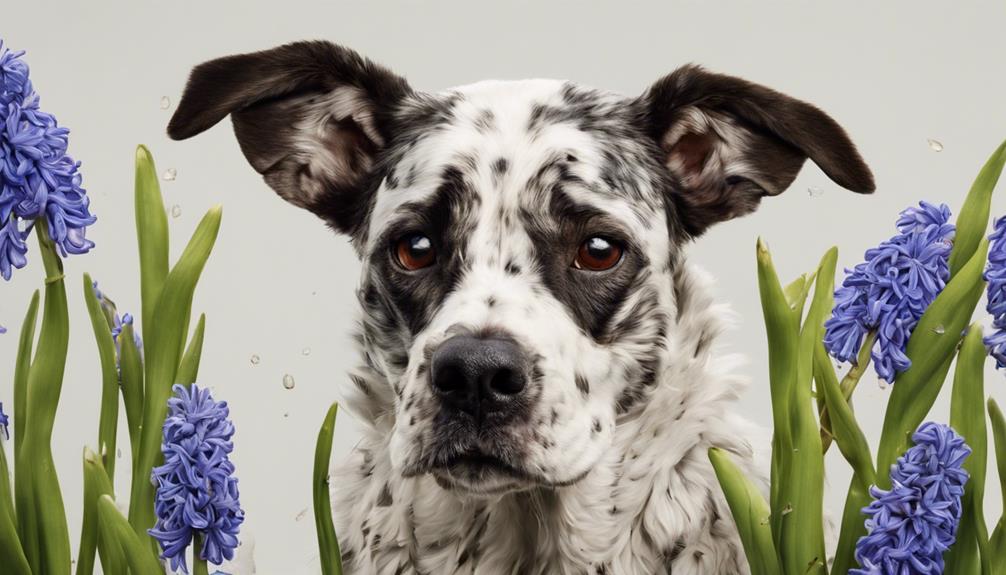
Hyacinth poisoning in dogs can cause drooling, vomiting, diarrhea, increased heart rate, and difficulty breathing. Toxic alkaloids in hyacinth bulbs are the main cause. To diagnose, look for clinical signs and conduct blood tests. Treatment involves calling ASPCA Poison Control, inducing vomiting, IV fluids, oxygen therapy, and medications. Recovery time varies. Costs average around $400, but pet insurance can help. Financial planning is important. Guarantee vet monitoring. Prevent hyacinth poisoning by being cautious. Understanding symptoms, causes, and treatments is essential for your pet's health and safety.
Key Takeaways
- Symptoms include drooling, vomiting, diarrhea, increased heart rate, and difficulty breathing.
- Toxic alkaloids in hyacinth bulbs cause poisoning; avoid ingestion and contact.
- Diagnosis involves evaluating signs, exposure history, and blood tests for toxicity.
- Treatment includes inducing vomiting, IV fluids, oxygen therapy, and supportive care.
- Recovery duration varies; mild cases improve in days, severe cases need longer monitoring.
Symptoms of Hyacinth Poisoning in Dogs
When dogs are affected by hyacinth poisoning, they may exhibit symptoms such as drooling, vomiting, diarrhea, increased heart rate, and difficulty breathing. These symptoms can be important for both the dog and their human companions. It's essential to be aware of the potential dangers that certain plants, like hyacinths, can pose to our canine friends.
Hyacinths contain toxins that are harmful to dogs when ingested. These plants, often found in gardens or homes, may seem harmless but can lead to serious health issues if a dog consumes them. The toxic compounds in hyacinths can quickly affect a dog's gastrointestinal system, leading to symptoms like drooling, vomiting, and diarrhea. Additionally, these toxins can impact other essential organs, causing increased heart rate and difficulty breathing. Understanding the toxic nature of certain plants, such as hyacinths, is crucial for ensuring the well-being of our furry companions.
Causes of Hyacinth Toxicity in Dogs
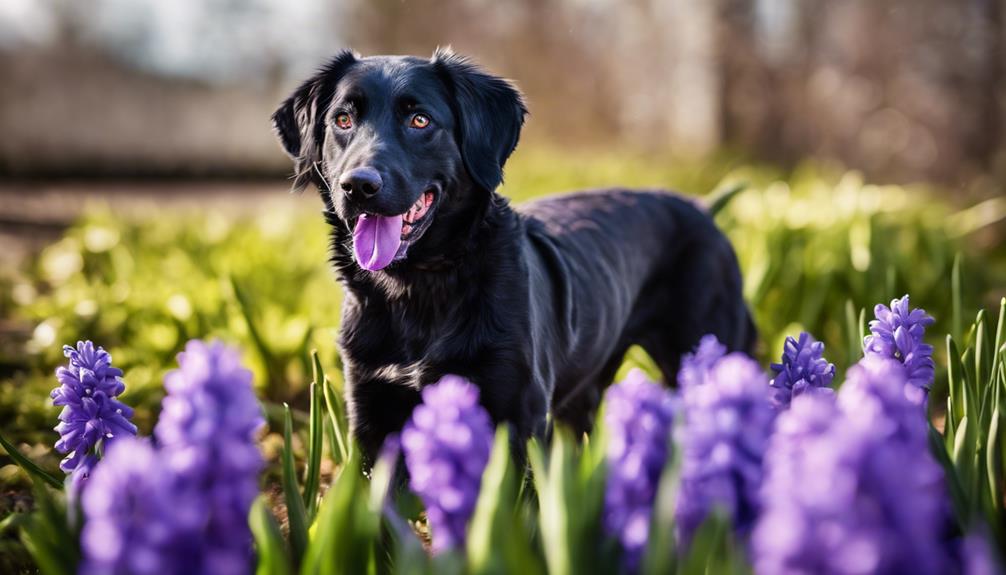
When it comes to the reasons for hyacinth toxicity in dogs, it's important to understand that the bulbs of the plant contain toxins like lycorine, which can harm our furry friends.
These toxins can lead to various symptoms of poisoning, affecting the gastrointestinal system and overall well-being of our canine companions.
Knowing the potential dangers and being aware of treatment options is essential for keeping our pets safe and healthy.
Hyacinth Toxins in Bulbs
Hyacinth toxicity in dogs arises primarily from the presence of toxic alkaloids, such as lycorine, found in the plant's bulbs. These toxic alkaloids can cause tissue irritation in the mouth and esophagus when ingested by dogs. Here is a table summarizing the causes of hyacinth toxicity:
| Causes of Hyacinth Toxicity in Dogs | Effects |
|---|---|
| Presence of toxic alkaloids | Tissue irritation |
| Ingestion of hyacinth bulbs | Severe health issues |
| Contact with toxic alkaloids | Drooling, vomiting |
| Exposure to lycorine | Diarrhea, increased heart rate, difficulty breathing |
Understanding these causes is essential in preventing accidental ingestion and the associated symptoms in dogs.
Symptoms of Poisoning
Typically, dogs may exhibit various symptoms of hyacinth poisoning upon ingesting any part of the plant, such as bulbs, leaves, or flowers. These symptoms can include vomiting, diarrhea, and mouth irritation.
When a dog ingests hyacinth, the toxic compounds in the plant can lead to gastrointestinal distress, causing the dog to drool excessively and experience stomach pain. Additionally, the irritant nature of hyacinths can result in tissue irritation in the mouth and esophagus, leading to discomfort and potential difficulty swallowing.
It's important to recognize these signs promptly, as delayed treatment can worsen the effects of poisoning. If you notice your dog displaying these symptoms after contact with hyacinths, seek immediate veterinary care for proper diagnosis and treatment.
Treatment Options for Dogs
Upon ingestion of toxic alkaloids like lycorine found in hyacinths, dogs may require prompt treatment to address the resulting health issues. If you suspect your dog has ingested hyacinths, contact the ASPCA Poison Control or your veterinarian immediately. They may recommend inducing vomiting to remove the toxins from your dog's system.
Additionally, your dog may need essential care, including IV fluids to prevent dehydration and electrolyte imbalances. Treatment will vary depending on the severity of the poisoning, so it's essential to seek professional help as soon as possible. Remember, quick action can greatly improve your dog's chances of a full recovery from hyacinth poisoning.
Diagnosis and Testing for Hyacinth Poisoning
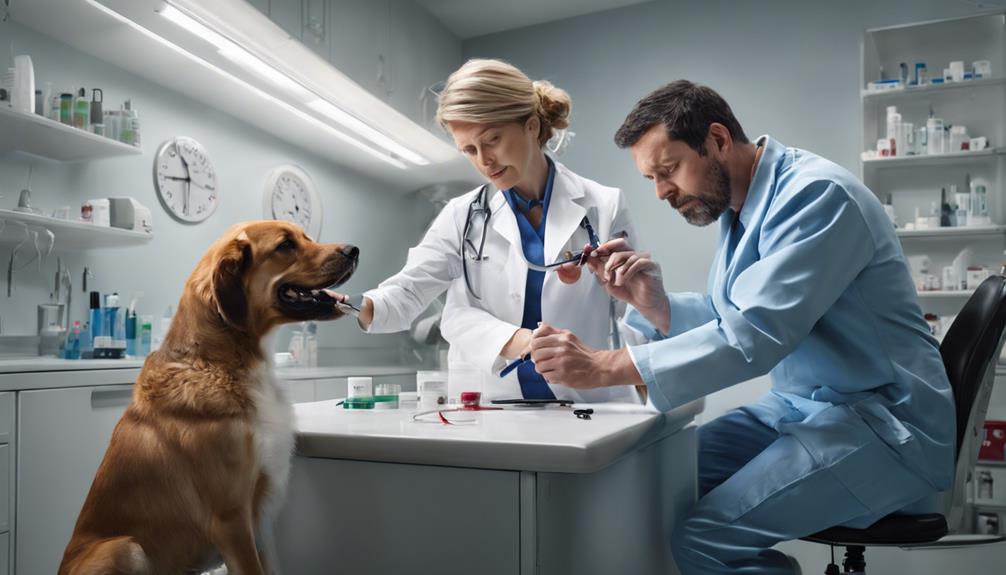
When diagnosing hyacinth poisoning in dogs, we evaluate clinical signs, exposure history, and conduct blood tests to detect toxic effects. Clinical signs such as vomiting and diarrhea are pivotal indicators that help us pinpoint potential hyacinth ingestion. Additionally, obtaining a thorough history of exposure to hyacinths or other toxic substances aids in confirming the diagnosis. Blood tests play an essential role in gauging the level of toxicity and guiding treatment decisions.
To emphasize the importance of clinical signs in diagnosing hyacinth poisoning, we have created a table below:
| Clinical Signs | Indicators | Importance |
|---|---|---|
| Vomiting | Gastrointestinal | Key Symptom |
| Diarrhea | Digestive System | Warning Sign |
| Drooling | Oral Irritation | Early Indicator |
Understanding these clinical signs can assist pet owners and veterinary professionals in recognizing potential hyacinth poisoning in dogs promptly. If you observe any of these symptoms in your pet, seek veterinary care immediately for proper diagnosis and treatment.
Treatment Options for Hyacinth Poisoning

In treating hyacinth poisoning in dogs, inducing vomiting may be considered to eliminate the plant material from the system. This can help rid the body of any remaining toxic plants that the dog ingested.
Additionally, administering activated charcoal can be beneficial as it aids in absorbing toxins and preventing further absorption in cases of hyacinth poisoning. Activated charcoal acts like a sponge, binding to the toxins in the gastrointestinal tract and preventing them from entering the bloodstream.
Along with these treatments, providing supportive care like intravenous fluids and monitoring essential signs is important for dogs affected by hyacinth poisoning. Depending on the severity of the poisoning, oxygen therapy and specific medications may also be utilized in the treatment process.
Recovery Timeline for Dogs With Hyacinth Poisoning
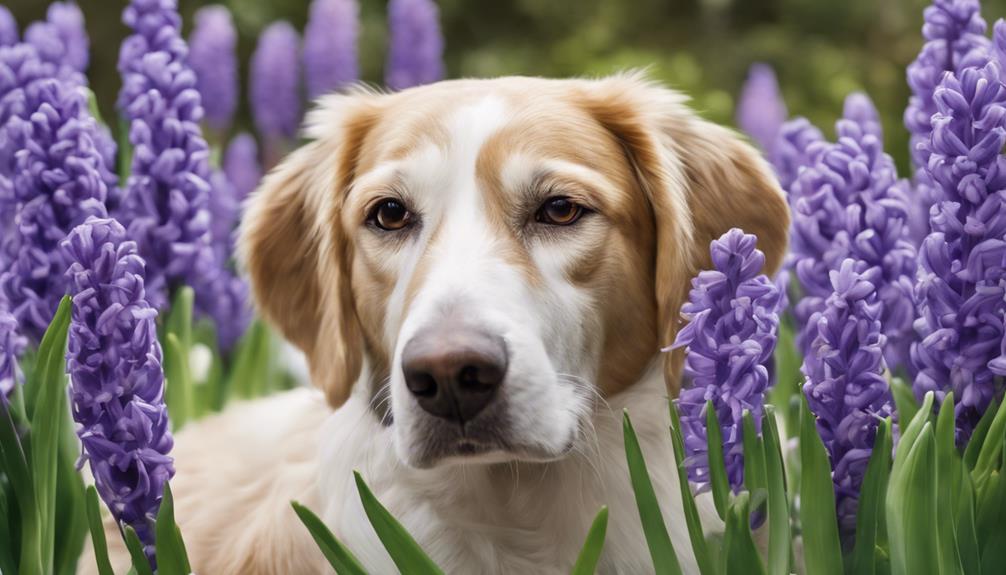
As dogs recover from hyacinth poisoning, the duration of their healing process depends on factors such as the quantity ingested and the severity of symptoms exhibited. Mild cases of hyacinth poisoning in dogs may show improvement within a few days with appropriate treatment. However, severe cases of hyacinth poisoning, where dogs display severe symptoms and potential organ damage, may require longer recovery periods and extensive veterinary care.
It is vital to understand that hyacinths are toxic to dogs, and any ingestion should be taken seriously. During the recovery process, regular monitoring by a veterinarian is essential to guarantee the dog's progress and adjust treatment as needed. Following treatment protocols diligently and providing a supportive environment can aid in the smooth recovery of dogs from hyacinth poisoning.
Management Tips for Preventing Hyacinth Poisoning

To avoid hyacinth poisoning in dogs, we recommend taking proactive steps such as installing barriers and using bitter sprays to deter access to the toxic plants. Dogs are naturally curious creatures, so it's crucial to create a safe environment by implementing the following measures:
- Install Physical Barriers: Setting up fences or other physical barriers around hyacinth plants can prevent dogs from coming into contact with the toxic parts.
- Elevate Hyacinth Plants: Consider placing hyacinth plants in elevated areas indoors where pets can't reach them, ensuring their safety.
- Use Bitter Sprays: Applying bitter sprays or deterrents on hyacinth plants can discourage dogs from consuming them, as the taste will be unpleasant.
Cost Considerations for Hyacinth Poisoning Treatment

When considering the costs associated with treating hyacinth poisoning in dogs, it's important to understand the factors that can influence the total expenses.
These factors include the severity of the poisoning, length of hospital stay, necessary tests, and medications required for treatment.
Exploring options such as pet insurance or discussing budget-friendly care alternatives with your veterinarian can help manage the financial aspect of your pet's treatment.
Treatment Expenses Overview
Considering various factors such as severity of poisoning and required treatments, the average cost of hyacinth poisoning treatment for dogs typically amounts to around $400 based on recent data. When facing such expenses, it's crucial to be prepared. Here are some key points to keep in mind:
- Pet insurance can help alleviate financial burdens.
- Contact the Pet Poison Helpline for guidance.
- Emergency clinics are available for immediate care needs.
Financial Assistance Options
Financial assistance options for hyacinth poisoning treatment costs can provide valuable support for dog owners facing unexpected veterinary expenses. Pet insurance is a helpful resource that can assist in covering the costs associated with treating hyacinth poisoning. These policies can help alleviate the financial burden by reimbursing a portion of the veterinary expenses incurred during the treatment process.
Considering the average cost of around $400 for hyacinth poisoning treatment, having pet insurance can offer peace of mind and financial security. It's essential to explore different pet insurance plans to find one that best suits your needs and provides adequate coverage for potential treatment costs. By being proactive and securing pet insurance before an emergency arises, you can better prepare for unforeseen veterinary expenses.
Budget-Friendly Care Alternatives
Exploring cost-effective options for hyacinth poisoning treatment is essential for ensuring the well-being of our furry companions without breaking the bank. When considering budget-friendly care alternatives for your pet, keep in mind the following:
- Pet Insurance: Consider investing in pet insurance to help cover unexpected veterinary expenses related to hyacinth poisoning treatments.
- Comparing Plans: Compare different pet insurance plans to find the most suitable coverage for your pet's health needs.
- Treatment Cost: The average cost of hyacinth poisoning treatment is around $400, but factors like severity, hospitalization, tests, and medications can influence this price.
Understanding these options can help you make informed decisions about your pet's healthcare while managing costs effectively.
Frequently Asked Questions
What Happens if My Dog Eats Hyacinth?
If your dog eats hyacinth, they may experience mouth irritation, vomiting, diarrhea, increased heart rate, and difficulty breathing. Symptoms can include drooling and abdominal pain.
Severe poisoning could lead to organ damage and ongoing health issues. It's imperative to recognize these signs promptly for timely veterinary care.
Are Hyacinths Poisonous to Dogs to Smell?
Yes, it's crucial to keep dogs away from hyacinths to prevent any potential harm. Hyacinths are poisonous to dogs, even by smelling them. The harmful compounds in hyacinths can cause damage to dogs through inhalation, leading to potential poisoning.
The aroma of hyacinths can irritate a dog's respiratory system and mucous membranes. Exposure to the scent of hyacinths, even without direct ingestion, can pose a risk to a dog's health.
Keeping dogs away from hyacinths is vital to avoid any potential harm.
What Part of the Hyacinth Is Poisonous?
When it comes to hyacinths, it's essential to know that the bulbs are the most poisonous part for dogs. Ingesting these bulbs can lead to serious health issues.
To keep our furry friends safe, we must prevent them from coming into contact with any part of the hyacinth plant, especially the bulbs.
Being aware of this toxicity can help us take proactive steps to protect our dogs from potential harm.
Are Hyacinth Beans Poisonous to Dogs?
Yes, hyacinth beans are toxic to dogs. Ingesting these beans can cause a range of symptoms from upset stomach to organ damage. It's essential to recognize the signs of poisoning and seek immediate veterinary care. Symptoms may include vomiting, diarrhea, and decreased appetite.
To protect our furry friends, it's important to keep hyacinth beans away from them and be vigilant for any signs of ingestion.
Conclusion
To sum up, while hyacinths may enhance the beauty of your garden, they can present a risk to our canine companions. Remember to keep a watchful eye on your furry friends and prevent them from consuming any part of the plant.
By being attentive and taking essential precautions, you can guarantee a safe environment for your beloved pets. Let's keep our gardens flourishing with flowers, not with potential hazards for our four-legged friends.
Dana is our Lead Content Writer, bringing a wealth of knowledge and expertise to our team. With a background deeply rooted in animal studies and a profound love for all creatures, Dana is dedicated to crafting engaging and informative content that resonates with our audience. With Dana at the helm, you can trust that our content is accurate and engaging, catering to the diverse interests of animal enthusiasts everywhere.
-

 Vetted2 months ago
Vetted2 months ago15 Best Cat Foods for Managing Hyperthyroidism – Vet Approved and Feline Friendly
-

 Vetted2 months ago
Vetted2 months ago15 Best Dog Foods for Kidney Disease – Expert Recommendations for Your Pet's Health
-

 Vetted2 months ago
Vetted2 months ago15 Best Fresh Dog Food Delivery Services for Your Pup's Health and Happiness
-
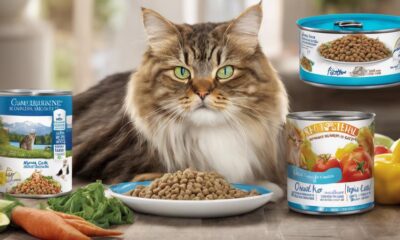
 Vetted2 months ago
Vetted2 months ago15 Best Wet Cat Foods for Older Cats to Keep Them Healthy and Happy
-

 Animal Facts2 months ago
Animal Facts2 months agoSpring Animals: A Guide to Seasonal Wildlife
-

 Vetted2 months ago
Vetted2 months ago14 Best Homemade Dog Food Recipes Your Pup Will Love – Vet Approved & Nutritious
-

 Cats1 month ago
Cats1 month agoCat Weight Chart by Age: Kitten to Senior in Lbs
-

 Cats2 weeks ago
Cats2 weeks agoTop 5 Cat Breeders in Arkansas: A Guide





















